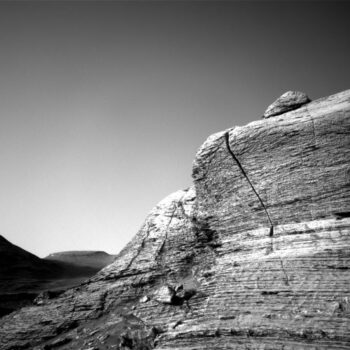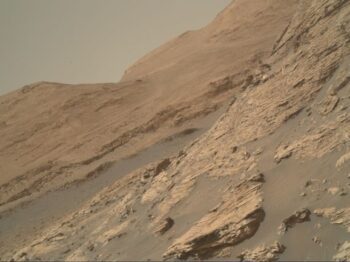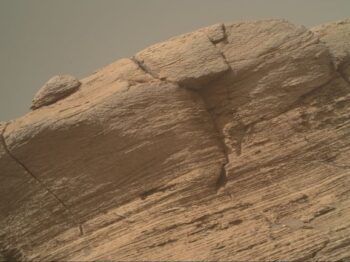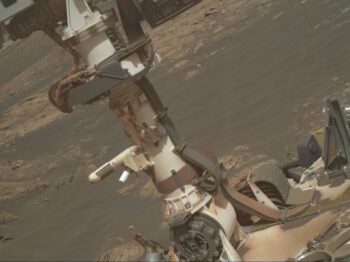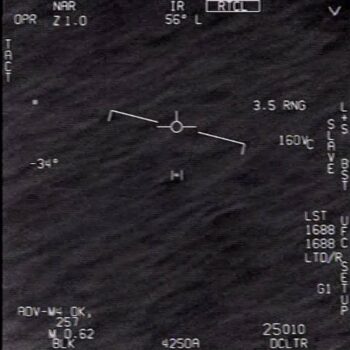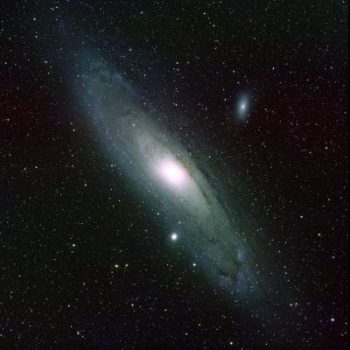Archive for March, 2021
A NASA “Send Your Name to Mars” website has stirred up Chinese officials.
The State Council Taiwan Affairs Office has lashed out at NASA for listing Taiwan as an independent country on a space agency website, “which is in blatant violation of international law,” reports China Central Television (CCTV).
According to Zhu Fenglian, spokeswoman, State Council Taiwan Affairs Office:
“Taiwan is an inalienable part of the Chinese territory. The National Aeronautics and Space Administration’s move violates the one-China principle and the provisions of the three China-U.S. joint communiqués, as well as the consensus of the international community, and hurts feelings of the Chinese people,” Zhu stated.
“We hope that the NASA, as an agency of the U.S. federal government, will respect China’s sovereignty and territorial integrity, abide by the one-China principle and the three China-U.S. joint communiqués, and correct its mistake as soon as possible. We also believe that Chinese people at home and abroad will have a correct understanding of this matter,” Zhu said at a press conference in Beijing.
Explore as one
NASA’s “Send Your Name to Mars” campaign invited people around the globe to submit their names to ride along on the rover – with a grand total of 10,932,295 names submitted.
The result of the NASA campaign was installed on the Perseverance Mars rover on March 16, 2020. Three fingernail-sized chips affixed to the upper-left corner of the placard feature the names of those individuals that participated.
Also on the plate: a laser-etched graphic depicting Earth and Mars connected by the rays of the Sun that gives light to both.
Written in Morse code in the Sun’s rays is a hidden message: “Explore As One.”
NASA response
Asking NASA to respond, Inside Outer Space received this message from Sean Potter, Media Relations Specialist in the NASA Headquarters’ Office of Communications:
“The appropriate field on the submission form has been updated to say ‘Location’ with the drop-down menu options updated to say ‘Country/Region/Territory’ to better reflect the diversity of geographic location types listed.”
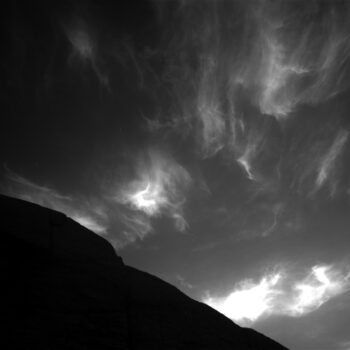
Clouds float over “Mont Mercou,”captured by Curiosity Right Navigation Camera image taken on Sol 3072, March 28, 2021
Credit: NASA/JPL-Caltech
NASA’s Curiosity Mars rover is now performing Sol 3074 tasks.
The forecast is in! There’s a high chance of clouds at “Mont Mercou!”
That’s the report from Catherine O’Connell-Cooper, a planetary geologist at the University of New Brunswick; Fredericton, New Brunswick, Canada.
“We are finishing up at the ‘Nontron’ drill locale and moving onto the next stage of investigating the beautiful Mont Mercou outcrop,” O’Connell-Cooper adds.
Mars researchers are continuing their usual cadence of looking at compositions and textures of the rover’s surroundings, using both the Mars Hand Lens Imager (MAHLI) and Alpha Particle X-Ray Spectrometer (APXS) to investigate the bedrock target “Bara Bahau.”
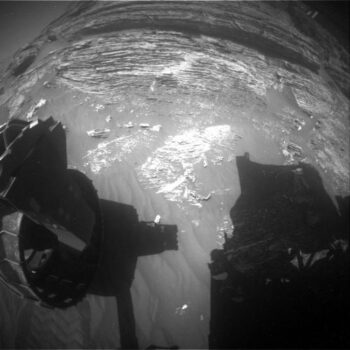
Curiosity Rear Hazard Avoidance Camera Left B image acquired on Sol 3073, March 29, 2021.
Credit: NASA/JPL-Caltech
Rumination about laminations
Before the robot moves onward, Mastcam is taking another opportunity to get close-up imaging of the extensive laminations on the cliff face, likely the last time the rover will be as close to the feature.
In a recently scripted plan, Curiosity is to drive around to the east side of the cliff and get into position to take Mastcam images of that side.
“Once we have documented that side, we will drive back across the front of the outcrop and image the western side,” O’Connell-Cooper explains. “This will provide us with a unique 3-D perspective on this cliff and will hopefully help our scientists to understand how this amazing outcrop formed.”

Curiosity Front Hazard Avoidance Camera Right B image taken on Sol 3073, March 29, 2021.
Credit: NASA/JPL-Caltech
Twilight cloud movie
The Environmental Theme Group (ENV) and Mastcam planned another twilight cloud movie for sol 3074, similar to that on sol 3072, which resulted in the incredible image of clouds above Mont Mercou.
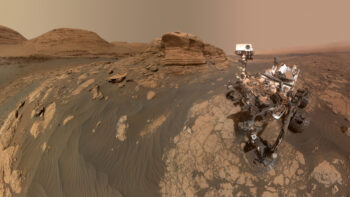
NASA’s Curiosity Mars rover used two cameras to create this selfie in front of Mont Mercou, a rock outcrop that stands 20 feet (6 meters) tall. Credit: NASA/JPL-Caltech/MSSS
“We are at the beginning of Gale crater’s cloudy season, and in the middle of a period where the potential for the formation of twilight clouds is higher than usual. ENV are taking advantage of this to observe and analyze clouds and cloud formations,” O’Connell-Cooper concludes.
Meanwhile, JPL has issued a set of new images that dramatically show the rover’s current whereabouts. Curiosity used its Mastcam instrument to produce these striking images and a panorama.
Image credits: NASA/JPL-Caltech/MSSS

NASA’s Curiosity Mars rover used its Mastcam instrument to take the 126 individual images that make up this 360-degree panorama.
Credit: NASA/JPL-Caltech/MSSS

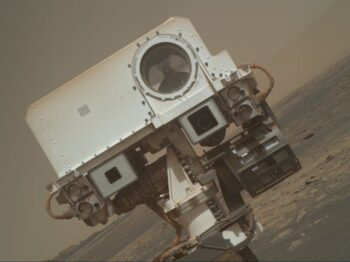
Curiosity Mars Hand Lens Imager (MAHLI) has produced a series of shots to piece together a rover selfie at the Nontron drill site. Images produced on Sol 3070, March 26, 2021.
Credit: NASA/JPL-Caltech/MSSS
NASA’s Curiosity Mars rover at Gale Crater is now performing Sol 3071 tasks.
Michelle Minitti, a planetary geologist at Framework in Silver Spring, Maryland reports: “We anticipate leaving our Nontron drill site in the next few sols, and just as you might snap one last picture of a memorable vacation spot, [the Mars Hand Lens Imager] MAHLI will wrap up the plan with a rover selfie featuring the spectacular ‘Mont Mercou’ in the background. Smile, Curiosity!”
New imagery from the rover clearly shows selfie imagery has been produced that will be shaped into a keepsake photo!
Final observations
“With a successful drill campaign at Nontron in the books, the team continued to wrap up drill hole observations and also grab some final observations of the interesting materials that mark this area,” Minitti adds.
The rover’s Chemistry and Camera (ChemCam) was slated to acquire a passive spectra of sulfate-bearing buttes that beckon from farther up “Mount Sharp.”
Curiosity’s Mastcam was scheduled to image sand targets “Thenac” and “Thenon” “to look for wind-induced changes, and the target “Creyssac,” a coherent crack in nearby sand to watch how – or if – it changes,” Minitti explains.
Looking for dust devils
The robot’s Mastcam and Navcam were also on tap to both monitor the amount of dust in the atmosphere, and Navcam will acquire a movie looking for dust devils.
Curiosity’s Radiation Assessment Detector (RAD), Rover Environmental Monitoring Station (REMS) and Dynamic Albedo of Neutrons (DAN) maintain their steady watch over the Gale crater environment through the plan, Minitti notes.
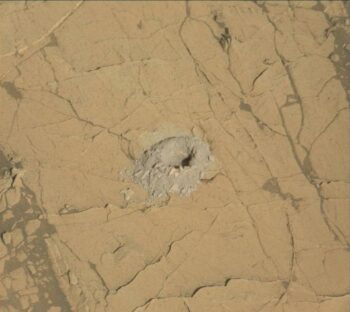
The Chassenon target is the white-gray-white striped feature at the edge of the bedrock block to the left of the drill hole in this image taken by rover’s Mast Camera on Sol 3056 March 12, 2021.
Credit: NASA/JPL-Caltech/MSSS
The Mars Hand Lens Imager (MAHLI) will image both spots that the Alpha Particle X-Ray Spectrometer (APXS) MAHLI analyzed on the pile of discarded Nontron drill sample in an earlier plan.
Multi-spot analysis
After the Nontron sample, MAHLI will team up with APXS for a multi-spot analysis, or raster, on the “Chassenon” target.
“We most commonly associate rasters with ChemCam, as moving through multiple spots in succession – sometimes in a grid, sometimes in a line – is how ChemCam analyzes a given target. Such rasters take 20-30 minutes, depending on the number of points in the raster,” Minitti reports. “A raster with APXS and MAHLI takes much longer!”
MAHLI and APXS are both at the end of the rover’s robotic arm, “so each MAHLI image and each APXS analysis relies on the arm and turret to gently and accurately place the instruments where the science team wants them to go,” Minitti adds. “Those arm motions are slow and careful, as you would expect if you were operating a 2-meter long arm weighing nearly 100 kilograms!”
Isolate the chemistry
If researchers only obtained a single APXS analysis over the center of Chassenon, Minitti says, the resulting chemistry would be a mix of that feature – the sand to its left and the bedrock to its right.
Minitti says that by adding two additional analyses – one slightly shifted off the center to get a mix of the feature and the surrounding bedrock, one over only bedrock – scientists can better isolate the chemistry of the feature.
“That is done by combining the chemistry from the APXS analyses with the proportions of materials in each APXS field of view, as determined with the MAHLI images that accompany each APXS analysis. The manner in which the chemistry varies with those proportions allows the chemistries of the individual materials to be separated,” Minitti explains.

Curiosity Mars Hand Lens Imager photo produced on Sol 3068, March 24, 2021.
Credit: NASA/JPL-Caltech/MSSS
NASA’s Curiosity Mars rover at Gale Crater is now performing Sol 3069 duties.
“It takes careful planning to manage the rover’s battery and power, much like we all manage our cell phone batteries and try to keep them charged. But we have to plan several sols ahead,” reports Scott Guzewich, an atmospheric scientist at NASA’s Goddard Space Flight Center in Greenbelt, Maryland.
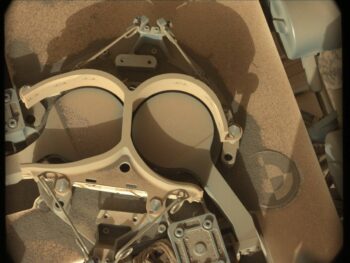
This recent Mastcam image shows the Sample Analysis at Mars (SAM) Instrument Suite inlet covers. Photo taken on Sol 3065, March 21, 2021.
Credit: NASA/JPL-Caltech/MSSS
Usually when Mars researchers plan a Sample Analysis at Mars (SAM) Instrument Suite activity, Guzewich adds, they expect a power “gift” in the next sol where SAM does not use as much power as we budgeted.
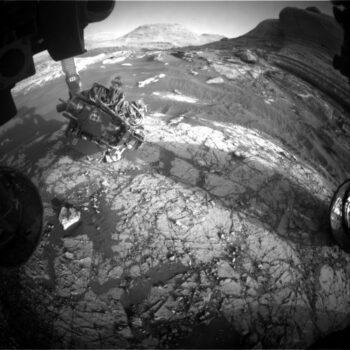
Curiosity Front Hazard Avoidance Camera Left image taken on Sol 3068, March 24, 2021.
Credit: NASA/JPL-Caltech
However, that was not the case, and combined with late changes to a recent plan, they had to deal with 5 percent less power than expected. That meant a drastic reduction in extra science time.
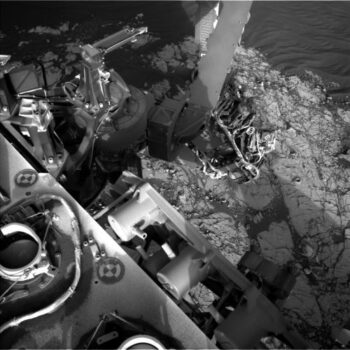
Curiosity Left B Navigation Camera photo acquired on Sol 3068, March 24, 2021.
Credit: NASA/JPL-Caltech
“We managed to still fit in a ChemCam [Chemistry and Camera] long-distance image mosaic, but otherwise are limited to our drill campaign activities” where the rover will dump the remaining powdered rock in the drill onto the surface and conduct contact science on that material with the Mars Hand Lens Imager (MAHLI) and the Alpha Particle X-Ray Spectrometer (APXS), Guzewich concludes.
A letter-writing campaign to Congress requesting transparency with respect to Unidentified Aerial Phenomenon (UAPs) is underway.
The activity has been sparked by a report that is due this June from a UAP Task Force established last year by the Department of Defense.
The Department of Defense established the task force “to improve its understanding of, and gain insight into, the nature and origins of UAPs. The mission of the task force is to detect, analyze and catalog UAPs that could potentially pose a threat to U.S. national security.”
Countdown underway
When the December, 2020 COVID-19 relief bill was signed into law, it triggered a 180-day “countdown” for intelligence agencies to provide a report to Congress summarizing what the government knows about the UAP situation.
The letter-writing campaign has a website, replete with a countdown clock, explaining that, for the first time in history, “American citizens have the opportunity to engage our government and influence the extent of the unclassified information included in this historic public report. The countdown to June 25, 2021 is underway!”
E-mail requests
A sample e-mail is provided so participants can request that 1) the unclassified assessment specifically address the longstanding assertion that the government is aware of craft of unknown origin displaying advanced operational capabilities that defy physical laws as humans understand them and 2) Congress and the Department of National Intelligence faithfully and honestly release these data and any additional evidence as part of the congressional report.”
Additionally, the sample e-mail also requests the release of “all historical data whose 25-year classification requirement has expired that has been collected over many decades by different intelligence agencies.”
NOTE: To reach the website, go to: https://uapactnow.com/
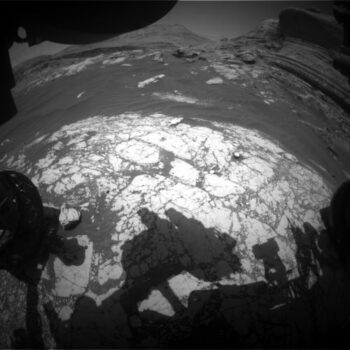
Curiosity Front Hazard Avoidance Camera Left B image showing recent drill hole taken on Sol 3067, March 23, 2021.
Credit: NASA/JPL-Caltech
NASA’s Curiosity Mars rover is now performing Sol 3068 tasks.
“Curiosity is still parked in front of the magnificent ‘Mont Mercou’ cliff face as we continue to work through analyses of the ‘Nontron’ drill site,” reports Lauren Edgar, a planetary geologist at the USGS Astrogeology Science Center in Flagstaff, Arizona.
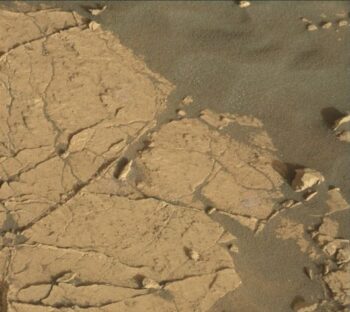
Curiosity Mast Camera Right photo acquired on Sol 3066, March 22, 2021.
Credit: NASA/JPL-Caltech/MSSS
Last weekend, the robot dropped off more sample to the Sample Analysis at Mars (SAM) Instrument Suite, followed by a planned SAM evolved gas analysis (EGA) in addition to other remote sensing activities.
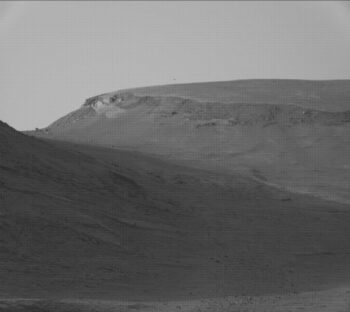
Curiosity Mast Camera Right photo acquired on Sol 3066, March 22, 2021.
Credit: NASA/JPL-Caltech/MSSS
Rim shot
A recent one sol plan starts with several environmental monitoring activities, including a Navcam line of sight observation and Mastcam image of the crater rim to characterize the dust content in the atmosphere.
Then the rover’s Chemistry & Camera (ChemCam) was on tap for several instrument calibration activities, followed by Remote Micro-Imager (RMI) mosaics of “Jayac” and “Journiac” to assess variations in laminae and diagenetic features exposed in the Mont Mercou cliff face, Edgar explains.

Curiosity Chemistry & Camera Remote Micro-Imager (RMI) photo acquired on Sol 3067, March 23, 2021.
Credit: NASA/JPL-Caltech/LANL
Spectacular stratification
Curiosity’s Mastcam was also scripted to take a super resolution mosaic “with the intent to increase the level of detail that we can see in an image by using slightly offset camera pointings,” Edgar adds.

Curiosity image of Mont Mercou cliff face taken by Right Navigation Camera, Sol 3065, March 21, 2021
Credit: NASA/JPL-Caltech
“We hope these observations will help us interpret the spectacular stratification seen” [in the Mont Mercou cliff face.] “Feeling inspired and humbled as Curiosity explores this beautiful outcrop!
China’s Chang’e-4 lunar lander and rover have been on the farside of the Moon for more than 800 Earth days. The mission landed on the Moon on January 3, 2019.
According to the Lunar Exploration and Space Program Center of the China National Space Administration (CNSA), both have been switched to dormant (sleep) mode after working stably for a 28th lunar day. A lunar day and the super-cold night each equals about 14 days on Earth.
The lander was switched to dormant mode at 2 a.m. Sunday (Beijing Time), and the rover, Yutu-2 (Jade Rabbit-2), at 5:09 p.m. Saturday, said the center.
The rover has traveled over 2,237.5 feet (682.77 meters) since its deployment on the lunar surface, within a crater called Von Kármán.
Landing site study
According to a Xinhua news story, researchers have made a series of scientific discoveries, including the mineral composition, topographic and geological evolution history of the landing site.
“Researchers from the Aerospace Information Research Institute under the Chinese Academy of Sciences analyzed the spectral characteristics of the rocks in the rover’s inspection area and inferred that the rocks probably originated from the Finsen impact crater,” Xinhua added.

Finsen is a lunar impact crater. Image taken by LROC imaging system aboard NASA’s Lunar Reconnaissance Orbiter (LRO).
Credit: NASA/GSFC/ASU
Finsen is a relatively young lunar impact crater on the Moon’s farside. Ejecta from Finsen covers the southeastern part of Leibnitz’s interior floor. To the southwest of Finsen is another walled plain, Von Kármán, partly overlain by Leibnitz.
The gaggle of SpaceX Starlink satellites circling the Earth stirs up the idea of installing planetary megastructures around our planet and the detection of that constellation of spacecraft by extraterrestrials as a “technosignature.”
A technosignature is a marker indicating that a particular technology is/was used by a particular society.
“Such a huge number of satellites, distributed over almost the whole surface of the Earth might be considered as the first prototype of a possible megastructure around the Earth, which in principal might be visible from the cosmos.”
That’s the view behind a new paper written by Zaza Osmanov of the Free University of Tbilisi in Tbilisi, Georgia.
Alien lookout
One has to note that the SpaceX Starlink satellites use radio communication, Osmanov notes in the research paper. Similarly, perhaps this Earth-circling network underscores the ability to look for technosignatures of alien civilizations.
A reasonable question to ask is whether it’s possible to detect ET radio signals by means of China’s now-operating Five-hundred-meter Aperture Spherical Radio Telescope (FAST) in southwest China’s Guizhou Province?
Faraway construction, Osmanov adds, would be visible in the infrared spectrum, which might be detectable by Very Large Telescope Interferometer (VLTI) instruments up to the distance of 260 light years, with roughly 103 Solar-type stars.
Osmanov concludes that extrapolating the idea that SpaceX’s Starlink constellation as a planetary megastructure is viable. “It has been found that for reasonable parameters FAST can detect such radio sources from relatively large distances.”
To read the paper — “From the SpaceX Starlink megaconstellation to the search for Type-I civilizations” – go to:
War and Peace in Outer Space Law, Policy, and Ethics, Edited by Cassandra Steer and Matthew Hersch; Oxford University Press; 334 Pages; January 2021; Hardcover: $99.00.
This impressive and highly readable book pulls together essays from a cavalcade of creative thinkers to take on not only space security and military prowess, but also the ethical, legal and illegal issues regarding the weaponization of outer space.
The co-editors are Cassandra Steer, a lecturer at the Australian National University (ANU) College of Law, specializing in space law and space security and Matthew Hersch, an associate professor of the History of Science at Harvard University specializing in the history of aerospace technology.
Hersch and Steer divide this volume into four parts: The Law of War and Peace in Space; The Ethics of Space Security; Current and Future Threats to Space Security; and (last but not least) Toward Stability. This book is part of the Oxford Series in Ethics, National Security, and the Rule of Law.
The essays are written by informed specialists, including independent legal and policy experts, a senior scientist, researchers and writers, professors – and a philosopher for good measure! All in all, this is a well-crafted book on military uses of outer that taps space interdisciplinary expertise, not only from the United States, but Canada and Europe.
“The reader should find plenty of content to stimulate inquiry, gain understanding, challenge personal preconceptions, test the ideas of others, and sharpen their own thinking on the subject matter,” explains now U.S. Space Force General, David Thompson in the book’s foreword. Indeed, the reader will find this statement solidly delivered via the various essays.
As Steer and Hersch note/warn in the introduction, yet another “critical moment” has arrived, due to a “discernible shift” in international rhetoric toward a more offensive approach to defense in space.
“A central theme in all of the chapters is that the best way to avoid capricious use of the space environment in wartime is to create an explicit set of norms in peacetime, recognizing that shared use, rather than dominance, is the preferred outcome for all spacefaring nations,” Hersch and Steer explain.
That said…this book also serves as a moving yardstick of where humankind now finds itself in the evolving use of outer space for military purposes. How we gauge actions of today with the reality of where spacefaring nations will find themselves a decade from now is a troublesome TBD.
For more information on this book, go to:
Also, go to this virtual book launch event staged by the Secure World Foundation, a “War and Peace in Outer Space” roundtable on Tuesday, March 23, 2021, 6pm eastern time. Register for this free virtual meeting at:
https://swfound.org/events/2021/roundtable-on-war-and-peace-in-outer-space
“Spaceships are dangerous things. There are no intentions implied to suggest otherwise,” writes Brian Binnie in his engrossing book, The Magic and Menace of SpaceShipOne.
On October 4, 2004, SpaceShipOne was released from its White Knight mothership, and with Binnie at the controls, he made the second suborbital flight in one week’s time to snag the $10 million Ansari X Prize flight purse. That pioneering passage of space and time marked a new era of commercial space flight.

SpaceShipOne, with Brian Binnie at the controls, flew the second suborbital flight in one week’s time in 2004 to capture the $10 million Ansari X Prize flight purse.
Courtesy Brian Binnie/Mike Mills
I recently talked with Binnie about his forty years of what he tags as “wrestling with recalcitrant machinery” – flying vehicles that are doing their best to be lethal, but proving to be useful training.
Go to my new Space.com story at:
“Test pilot Brian Binnie recounts his historic flight on SpaceShipOne and the future of private space travel in new book” via Space.com:
https://www.space.com/spaceshipone-test-pilot-brian-binnie-book-interview



